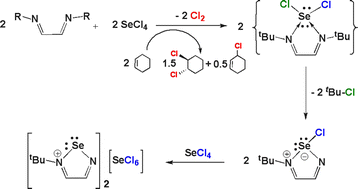Synthesis and characterization of cationic selenium–nitrogen heterocycles from tert-butyl-DAB (DAB = 1,4-di-tert-butyl-1,3-diazabutadiene) and SeX4via the reductive elimination of X2 (X = Cl, Br): a distinct contrast with tellurium†
Abstract
The synthesis and comprehensive characterisation of a series of 1,2,5-selenadiazolium salts, which were generated from the direct reaction between the neutral bidentate

- This article is part of the themed collection: Main group chemistry: from molecules to materials

 Please wait while we load your content...
Please wait while we load your content...